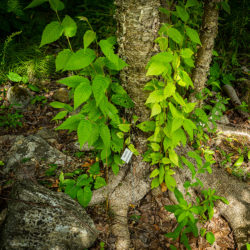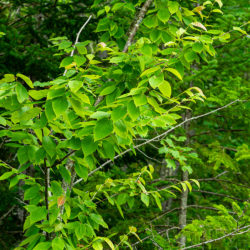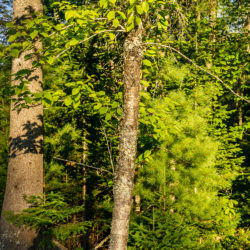Etymology
Betula is Latin for birch tree, a tree whose ‘bark is used for writing upon’; alleghaniensis is Latin for found in the vicinity of the Allegheny River or Mountains.
Native Habitat
Stream banks, swampy woods, and rich, moist, forested slopes.
Garden Uses
Specimen or grove plantings. Prune for shaping only after sap has stopped flowing in the summer.
Overview
The largest eastern birch, growing up to 100 ft tall, and still one of the most valuable lumber hardwoods in the northeast. It is also the longest lived birch, easily reaching 100 years or more. The canopy of an open-grown tree takes a massive candelabra form, while forest grown trees remain slender. It grows well in part-shade to shade, and prefers moist to wet soils. Young trees can be mistaken for cherry birch due to a similar wintergreen fragrance of the twigs and leaves; this tree is distinguished by the hairiness of its young stems.
Leaves and Stems
Leaves emerge after catkins, and are simple, alternate, and elliptical, 2-4" long, and double toothed. They are hairy when young, then smooth, with mostly unbranched side veins. Leaves are dark green above and yellow underneath when mature, changing to blaze yellow in autumn. Twigs and buds are also uniquely hairy their first year, but then become smooth. Bark of young trees, and on the stems and branches of mature trees, is shiny, translucent, and vividly golden-yellow, shedding in curling, narrow strips, rather than peeling in sheets. Bark is streaked with gray and brown. Twigs and foliage are both aromatic.
Flowers
Showy yellow or green catkins emerge before leaves. Both male and female catkins are on the same tree (monoecious). Male catkins are in groups of 1 to 3, at the tips of 1-year old twigs, and hang 2-4" long. Female catkins are erect, cylindrical, wider, and shorter (3/4-1-1/2" long), and grow from new, spur-like lateral twigs on the same branches as the males.
Fruit/Seed
Female catkins become oval, cone-like clusters about one inch long, composed of winged nutlets, each around 1/8 inch long, which dry from green to tan or brown.
Animal Associates
As with all birches, this species is a host to many insect larvae, both beneficial pollinators or destructive (e.g. bronze birch borer). Seeds are an important food for birds.
Propagation
Can be seed grown; collect catkins directly into a bag, while they are still green enough to hold together during summer, and provide one month cold stratification.
Ethnobotanical Uses
Historically prized for shipbuilding due to its resinous, rot resistant wood, it is currently the source of almost all birch used in furniture, cabinets, and building.
Garden Location
Performance Hall Garden, South Woods (see garden map)
Sources
Lady Bird Johnson Wildflower Center
Plant Profile by Kate O’Dell



